Papers by Jailson Alcaniz
Journal of Cosmology and Astroparticle Physics
We investigate the early universe evolution in the context of brane inflation driven by a supergr... more We investigate the early universe evolution in the context of brane inflation driven by a supergravity-inspired arctan potential. We performed a slow-roll and a semi-analytical reheating analyses and obtained constraints on the inflationary parameters in agreement with Planck 2018 data. We also employed a Markov Chain Monte Carlo analysis to perform a parameter estimation of the cosmological parameters, obtaining results in good agreement with the currently available cosmic microwave background and baryon acoustic oscillation data. This work establishes the general theoretical predictions of the arctan model, with the results of the statistical analysis corroborating its observational viability.
Journal of Cosmology and Astroparticle Physics
We investigate the early universe evolution in the context of brane inflation driven by a supergr... more We investigate the early universe evolution in the context of brane inflation driven by a supergravity-inspired arctan potential. We performed a slow-roll and a semi-analytical reheating analyses and obtained constraints on the inflationary parameters in agreement with Planck 2018 data. We also employed a Markov Chain Monte Carlo analysis to perform a parameter estimation of the cosmological parameters, obtaining results in good agreement with the currently available cosmic microwave background and baryon acoustic oscillation data. This work establishes the general theoretical predictions of the arctan model, with the results of the statistical analysis corroborating its observational viability.
Journal of Cosmology and Astroparticle Physics
The β-exponential inflation is driven by a class of primordial potentials, derived in the framewo... more The β-exponential inflation is driven by a class of primordial potentials, derived in the framework of braneworld scenarios, that generalizes the well-known power law inflation. In this paper we update previous constraints on the minimal coupled β-exponential model [1] and extend the results also deriving the equations for the non-minimal coupled scenario. The predictions of both models are tested in light of the latest temperature and polarization maps of the Cosmic Microwave Background and clustering data. We also compare the predictions of these models with the standard ΛCDM cosmology using the Deviance Information Criterion (DIC), and find that the observational data show a moderate preference for the non-minimally coupled β-exponential inflationary model.
Journal of Cosmology and Astroparticle Physics
The β-exponential inflation is driven by a class of primordial potentials, derived in the framewo... more The β-exponential inflation is driven by a class of primordial potentials, derived in the framework of braneworld scenarios, that generalizes the well-known power law inflation. In this paper we update previous constraints on the minimal coupled β-exponential model [1] and extend the results also deriving the equations for the non-minimal coupled scenario. The predictions of both models are tested in light of the latest temperature and polarization maps of the Cosmic Microwave Background and clustering data. We also compare the predictions of these models with the standard ΛCDM cosmology using the Deviance Information Criterion (DIC), and find that the observational data show a moderate preference for the non-minimally coupled β-exponential inflationary model.
arXiv: General Relativity and Quantum Cosmology, Oct 25, 2021
We discuss the power of third-generation gravitational wave detectors to constrain cosmographic p... more We discuss the power of third-generation gravitational wave detectors to constrain cosmographic parameters in the case of electromagnetically bright standard sirens focusing on the specific case of the Einstein Telescope. We analyze the impact that the redshift source distribution, the number of detections and the observational error in the luminosity distance have on the inference of the first cosmographic parameters, and show that with a few hundreds detections the Hubble constant can be recovered at sub-percent level whereas the deceleration parameter at a few percent level, both with negligible bias.
We report five measurements of the transverse baryonic acoustic scale, θ_BAO, obtained from the a... more We report five measurements of the transverse baryonic acoustic scale, θ_BAO, obtained from the angular two-point correlation function calculation for Luminous Red Galaxies of the eleventh data release of the Sloan Digital Sky Survey (SDSS). Each measurement has been obtained by considering a thin redshift shell (δ z = 0.01 and 0.02) in the interval z ∈ [0.565, 0.660], which contains a large density of galaxies (∼ 20,000 galaxies/redshift shell). Differently from the three-dimensional Baryon Acoustic Oscillations (BAO) measurements, these data points are obtained almost model-independently and provide a Cosmic Microwave Background (CMB)-independent way to estimate the sound horizon r_s. Assuming a time-dependent equation-of-state parameter for the dark energy, we also discuss constraints on the main cosmological parameters from θ_BAO and CMB data.
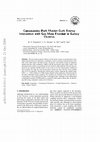
The recent observational evidence for the current cosmic acceleration have stimulated renewed int... more The recent observational evidence for the current cosmic acceleration have stimulated renewed interest in alternative cosmologies, such as scenarios with interaction in the dark sector (dark matter and dark energy). In general, such models contain an unknown negative-pressure dark component coupled with the pressureless dark matter and/or with the baryons that results in an evolution for the Universe rather different from the one predicted by the standard ΛCDM model. In this work we test the observational viability of such scenarios by using the most recent galaxy cluster gas mass fraction versus redshift data (42 X-ray luminous, dynamically relaxed galaxy clusters spanning the redshift range 0.063 < z < 1.063) (Allen et al. 2008) to place bounds on the parameter ǫ that characterizes the dark matter/dark energy coupling. The resulting are consistent with, and typically as constraining as, those derived from other cosmological data. Although a time-independent cosmological constant (ΛCDM model) is a good fit to these galaxy cluster data, an interacting dark energy component cannot yet be ruled out.
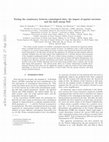
Journal of Cosmology and Astroparticle Physics, 2021
The results of joint analyses of available cosmological data have motivated an important debate a... more The results of joint analyses of available cosmological data have motivated an important debate about a possible detection of a non-zero spatial curvature. If confirmed, such a result would imply a change in our present understanding of cosmic evolution with important theoretical and observational consequences. In this paper we discuss the legitimacy of carrying out joint analyses with the currently available data sets and explore their implications for a non-flat universe and extensions of the standard cosmological model. We use a robust tension estimator to perform a quantitative analysis of the physical consistency between the latest data of Cosmic Microwave Background, type Ia supernovae, Baryonic Acoustic Oscillations and Cosmic Chronometers. We consider the flat and non-flat cases of the ΛCDM cosmology and of two dark energy models with a constant and varying dark energy EoS parameter. The present study allows us to better understand if possible inconsistencies between these d...
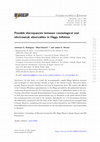
Journal of High Energy Physics, 2021
In this work, we revisit the non-minimally coupled Higgs Inflation scenario and investigate its o... more In this work, we revisit the non-minimally coupled Higgs Inflation scenario and investigate its observational viability in light of the current Cosmic Microwave Background, Baryon Acoustic Oscillation and type Ia Supernovae data. We explore the effects of the Coleman-Weinberg approximation to the Higgs potential in the primordial universe, connecting the predictions for the Lagrangian parameters at inflationary scales to the electroweak observables through Renormalization Group methods at two-loop order. Initially, we find that electroweak scale measurements may be dissonant to the limits obtained from the cosmological data sets used in the analysis. Specifically, an ≈ 8σ-discrepancy between the inflationary parameters and the value of the Monte Carlo reconstructed top quark mass is found. However, considering the most recent results obtained by the CMS Collaboration from differential cross-section measurements of the top quark production a good agreement is obtained.
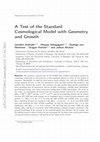
Journal of Cosmology and Astroparticle Physics, 2021
We perform a general test of the ΛCDM and wCDM cosmological models by comparing constraints on th... more We perform a general test of the ΛCDM and wCDM cosmological models by comparing constraints on the geometry of the expansion history to those on the growth of structure. Specifically, we split the total matter energy density, Ω M , and (for wCDM) dark energy equation of state, w, into two parameters each: one that captures the geometry, and another that captures the growth. We constrain our split models using current cosmological data, including type Ia supernovae, baryon acoustic oscillations, redshift space distortions, gravitational lensing, and cosmic microwave background (CMB) anisotropies. We focus on two tasks: (i) constraining deviations from the standard model, captured by the parameters ∆Ω M ≡ Ω grow M −Ω geom M and ∆w ≡ w grow −w geom , and (ii) investigating whether the S 8 tension between the CMB and weak lensing can be translated into a tension between geometry and growth, i.e. ∆Ω M = 0, ∆w = 0. In both the split ΛCDM and wCDM cases, our results from combining all data are consistent with ∆Ω M = 0 and ∆w = 0. If we omit BAO/RSD data and constrain the split wCDM cosmology, we find the data prefers ∆w < 0 at 3.6σ significance and ∆Ω M > 0 at 4.2σ evidence. We also find that for both CMB and weak lensing, ∆Ω M and S 8 are correlated, with CMB showing a slightly stronger correlation. The general broadening of the contours in our extended model does alleviate the S 8 tension, but the allowed nonzero values of ∆Ω M do not encompass the S 8 values that would point toward a mismatch between geometry and growth as the origin of the tension.
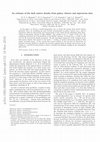
Journal of Cosmology and Astroparticle Physics, 2019
In this paper, we discuss a model-independent way to obtain the present dark matter density param... more In this paper, we discuss a model-independent way to obtain the present dark matter density parameter (Ωc,0) by combining gas mass fraction measurements in galaxy clusters (fgas), type Ia supernovae (SNe Ia) observations and measurements of the cosmic baryon abundance from observations of absorption systems at high redshifts. Our estimate is Ωc,0 = 0.244 ± 0.013 (1σ). By considering the latest local measurement of the Hubble constant, we obtain ΩM,0 = 0.285 ± 0.013 (1σ) for the total matter density parameter. We also investigate departures of the evolution of the dark matter density with respect to the usual a −3 scaling, as usual in interacting models of dark matter and dark energy. As the current data cannot confirm or rule out such an interaction, we perform a forecast analysis to estimate the necessary improvements in number and accuracy of upcoming fgas and SNe Ia observations to detect a possible non-minimal coupling in the cosmological dark sector.
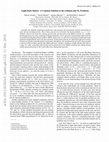
Physics Letters B, 2021
Currently, the standard cosmological model faces some tensions and discrepancies between observat... more Currently, the standard cosmological model faces some tensions and discrepancies between observations at early and late cosmological time. One of them concerns the well-known H0-tension problem, i.e., a ∼ 4.4σdifference between the early-time estimate and late-time measurements of the Hubble constant, H0. Another puzzling question rests in the cosmological lithium abundance, where again local measurements differ from the one predicted by Big Bang Nucleosynthesis (BBN). In this work, we show that a mechanism of light dark matter production might hold the answer for these questions. If dark matter particles are sufficiently light and a fraction of them were produced non-thermally in association with photons, this mechanism has precisely what is needed to destroy Lithium without spoiling other BBN predictions. Besides, it produces enough radiation that leads to a larger H0 value, reconciling early and late-time measurements of the Hubble expansion rate without leaving sizable spectral distortions in the Cosmic Microwave Background spectrum.
Journal of Cosmology and Astroparticle Physics, 2021
We report measurements of the scale of cosmic homogeneity (rh) using the recently released quasar... more We report measurements of the scale of cosmic homogeneity (rh) using the recently released quasar sample of the sixteenth data release of the Sloan Digital Sky Survey (SDSS-IV DR16). We perform our analysis in 2 redshift bins lying in the redshift interval 2.2 < z < 3.2 by means of the fractal dimension D_2. By adopting the usual assumption that rh is obtained when D2 ∼ 2.97, that is, within 1% of D2=3, we find the cosmic homogeneity scale with a decreasing trend with redshift, and in good agreement with the ΛCDM prediction. Our results confirm the presence of a homogeneity scale in the spatial distribution of quasars as predicted by the fundamental assumptions of the standard cosmological model.
The European Physical Journal Plus, 2020
In this paper, we present a unified scheme based on the fluid description of the dark sector of t... more In this paper, we present a unified scheme based on the fluid description of the dark sector of the universe. The scheme captures models with interaction between dark energy and dark matter, being the core of generalization the time-varying equation-of-state parameter ω(a) and the time-dependent interactions through the interaction function (a), where a is the scale factor. Furthermore, we propose thermodynamics constraints on this generalized class of models using the laws of thermodynamics which are combined with observational data. In order to test the observational viability of the unified model, we perform a Bayesian analysis using cosmic chronometers, type Ia supernovae, cosmic microwave background, and angular baryon acoustic oscillation measurements.
Astroparticle Physics, 2020
We report five measurements of the transverse baryonic acoustic scale, θ BAO , obtained from the ... more We report five measurements of the transverse baryonic acoustic scale, θ BAO , obtained from the angular two-point correlation function calculation for Luminous Red Galaxies of the eleventh data release of the Sloan Digital Sky Survey (SDSS). Each measurement has been obtained by considering a thin redshift shell (δz = 0.01 and 0.02) in the interval z ∈ [0.565, 0.660], which contains a large density of galaxies (∼ 20, 000 galaxies/redshift shell). Differently from the three-dimensional Baryon Acoustic Oscillations (BAO) measurements, these data points are obtained almost model-independently and provide a Cosmic Microwave Background (CMB)-independent way to estimate the sound horizon r s. Assuming a timedependent equation-of-state parameter for the dark energy, we also discuss constraints on the main cosmological parameters from θ BAO and CMB data.
Journal of Cosmology and Astroparticle Physics, 2019
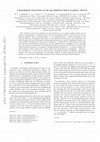
Journal of Cosmology and Astroparticle Physics, 2017
The evolution of the X-ray emitting gas mass fraction (fgas) in massive galaxy clusters can be us... more The evolution of the X-ray emitting gas mass fraction (fgas) in massive galaxy clusters can be used as an independent cosmological tool to probe the expansion history of the Universe. Its use, however, depends upon a crucial quantity, i.e., the depletion factor γ, which corresponds to the ratio by which fgas is depleted with respect to the universal baryonic mean. This quantity is not directly observed and hydrodynamical simulations performed in a specific cosmological model (e.g., a flat ΛCDM cosmology) have been used to calibrate it. In this work, we obtain for the first time self-consistent observational constraints on the gas depletion factor combining 40 X-ray emitting gas mass fraction measurements and luminosity distance measurements from type Ia supernovae. Using Gaussian Processes to reconstruct a possible redshift evolution of γ, we find no evidence for such evolution, which confirms the current results from hydrodynamical simulations. Moreover, our constraints on γ can be seen as a data prior for cosmological analyses on different cosmological models. The current measurements are systematic limited, so future improvements will depend heavily on a better mass calibration of galaxy clusters and their measured density profiles.
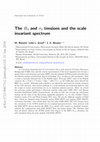
Journal of Cosmology and Astroparticle Physics, 2018
In a previous communication [1] it was shown that a joint analysis of Cosmic Microwave Background... more In a previous communication [1] it was shown that a joint analysis of Cosmic Microwave Background (CMB) data and the current measurement of the local expansion rate favours a model with a scale invariant spectrum (HZP) over the minimal ΛCDM scenario provided that the effective number of relativistic degrees of freedom, N ef f , is taken as a free parameter. Such a result is basically obtained due to the Hubble Space Telescope (HST) value of the Hubble constant, H 0 = 73.24 ± 1.74 km.s −1 .Mpc −1 (68% C.L.), as the CMB data alone discard the HZP+N ef f model. Although such a model is not physically motivated by current scenarios of the early universe, observations pointing to a scale invariant spectrum may indicate that the origin of cosmic perturbations lies in an unknown physical process. Here, we extend the previous results performing a Bayesian analysis using joint CMB, HST, and Baryon Acoustic Oscillations (BAO) measurements. In order to take into account the well-known tension on the value of the fluctuation amplitude parameter, σ 8 , we also consider Cluster Number counts (CN) and Weak Lensing (WL) data. We use two different samples of BAO data, which are obtained using two-point spatial (BAO 2PCF) and angular (BAO 2PACF) correlation functions. Our results show that the joint CMB+HST+WL+NC dataset favor the extensions of the ΛCDM model over its minimal parameterization. Also, analysis with the BAO 2PCF always discard the HZP+N ef f model with respect to standard scenario, whereas the combinations using BAO 2PACF favor the former model. We, therefore, find that all dataset disfavor the ΛCDM model with respect to the HZP+N ef f extension, the only exception being the joint analysis with BAO (2PCF).
Classical and Quantum Gravity, 2018
We use a dynamical system approach to study the cosmological viability of f (R, G) gravity theori... more We use a dynamical system approach to study the cosmological viability of f (R, G) gravity theories. The method consists of formulating the evolution equations as an autonomous system of ODEs, using suitable variables. The formalism is applied to a class of models in which f (R, G) ∝ R n G 1−n and its solutions and corresponding stability are analysed in detail. New accelerating solutions that can be attractors in the phase space are found. We also find that this class of models does not exhibit a matter-dominated epoch, a solution which is inconsistent with current cosmological observations.
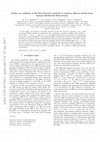
Physics Letters B, 2017
In this paper, new bounds on possible variations of the fine structure constant, α, for a class o... more In this paper, new bounds on possible variations of the fine structure constant, α, for a class of runaway dilaton models are performed. By considering a possible evolution with redshift, z, such as ∆α α = −γ ln(1 + z), where in γ are the physical properties of the model, we constrain this parameter by using a deformed cosmic distance duality relation jointly with gas mass fraction (GMF) measurements of galaxy clusters and luminosity distances of type Ia supernovae. The GMF's used in our analyses are from cluster mass data from 82 galaxy clusters in the redshift range 0.12 < z < 1.36, detected via the Sunyaev-Zeldovich effect at 148 GHz by the Atacama Cosmology Telescope. The type Ia supernovae are from the Union2.1 compilation. We also explore the dependence of the results from four models used to describe the galaxy clusters. As a result no evidence of variation was obtained.

Uploads
Papers by Jailson Alcaniz